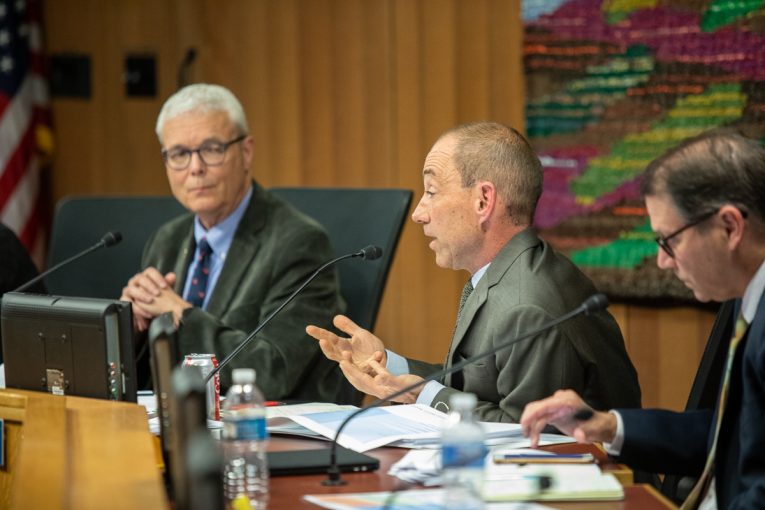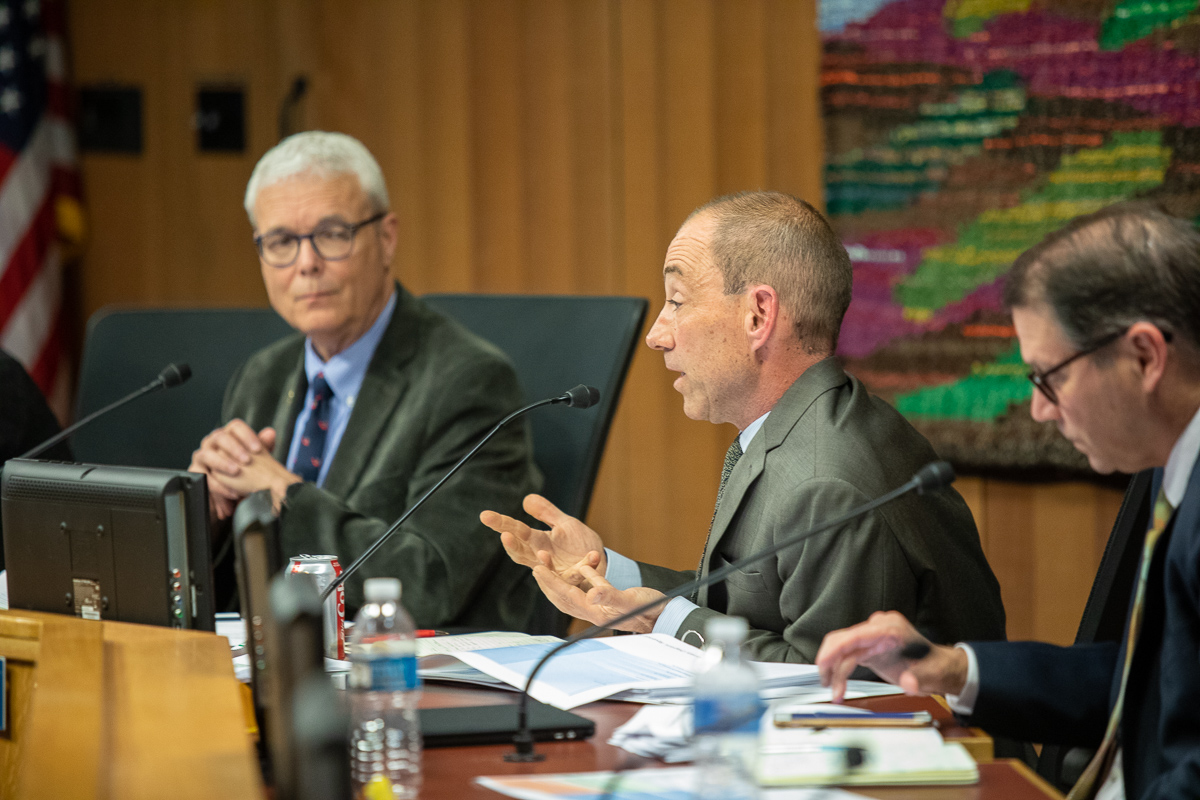

As it turned out the school board was not going to have much choice—but nevertheless during a special meeting on Friday morning, the DJUSD Board of Education and Superintendent Bowes announced a recommendation to restart all DJUSD schools on August 26, 2020, in a 100% Distance Learning Model.
“The health and safety of our students and employees is our top concern and not something that we are willing to put at risk in this current environment,” said John Bowes.
The district was probably headed this way anyway, but the governor’s announcement made it both an easy call and a moot point.
“Learning is non-negotiable,” said Governor Newsom. “The virus will be with us for a year or more, and school districts must provide meaningful instruction in the midst of this pandemic. In California, health data will determine when a school can be physically open – and when it must close – but learning should never stop. Students, staff, and parents all prefer in-classroom instruction, but only if it can be done safely.”
Any county that does not meet the state’s benchmarks is put on the County Monitoring List. They currently use six indicators to track the level of COVID-19 infection—these include the number of new infections per 100,000 residents, the test positivity rate, and the change in hospitalization rate, among others.
Yolo County, which passed 1000 cases this week after being at 255 in mid-June, is on that list.
Schools located in counties that are on the Monitoring List must not physically open for in-person instruction until their county has come off the Monitoring List for 14 consecutive days.
Schools in counties that have not been on the Monitoring List for the prior 14 days may begin in-person instruction, following public health guidelines
There is a single exception. Local health officers may grant a waiver to allow elementary schools to reopen in-person instruction if the waiver is requested by the district superintendent, in consultation with labor, parents and community-based organizations. When considering a waiver request, the local health officer must consider local data and consult with the California Department of Public Health.
On Friday, Dr. Mary Ann Limbos, Acting Public Health Officer for Yolo County, joined the board meeting.
She explained, “When districts are deciding how to safely re-open schools this fall, a paramount consideration is what’s happening with disease transmission in the surrounding community. Over the past few weeks, Yolo County has seen increasing case rates and transmission of COVID-19 and we are on the State of California’s County Monitoring List because of our concerning metrics.
“We want students, teachers, and school staff to have a safe return to school,” Limbos said. “The current pandemic doesn’t support the safe re-opening of schools with in-person instruction at this time.”
Board members also expressed concerns about the current health situation.
Board President Joe DiNunzio encouraged staff to provide specifics for how Distance Learning in the 2020-21 school year will meet both the academic and the social and emotional needs of all students, and especially of those who may be furthest from opportunity.
“As we consider how we educate our students in this current environment, we need to provide special care and attention to individual needs of students and families, especially to ensure we are doing everything we can to provide equitable access to education,” DiNunzio said.
As next steps, the Board of Education will be receiving a detailed presentation on the DJUSD Phased Return-to-Campus Plan at their Regular Board of Education meeting on Thursday, July 23.
The presentation will focus on the restart of school, including details about the phases of returning to in-person instruction, supports for equity and access, schedules and structures for instruction, social emotional learning supports, health and safety guidelines, and practices to support student engagement and assessment.
—David M. Greenwald reporting







“There is a single exception. Local health officers may grant a waiver to allow elementary schools to reopen in-person instruction if the waiver is requested by the district superintendent, in consultation with labor, parents and community-based organizations. When considering a waiver request, the local health officer must consider local data and consult with the California Department of Public Health.”
In keeping with my new policy of speaking my mind clearly and fully, I see this exception as a huge mistake. Yolo County is a prime example of why. When Yolo began its progression through the state guidance criteria, it did not meet all of those criteria but was allowed to proceed through attestation by the health officer. The results of that decision are clearly visible on the county dashboard. As Brian Vaughn honestly stated, to his credit, we didn’t think the increase would be as large. Can we look at our own results and those of other “early openers” and please not repeat the same mistake again and again?
I don’t know really know the context for this exception, but I can see that it could benefit certain low income families where the parents have to work (probably blue-collar type jobs away from home), where daycare may not be feasible, and where the kids may not have the kind of home environment to support distance learning very well. If there were teachers who fully understood that situation and were willing to work under those conditions, and there were efforts made to limit student enrollment at the site so as to optimize physical spacing and safety.
I think some students with IEP’s would need in-person instruction and support.
Yep. But perhaps not in the standard IEP setting where 0ne teacher has to deal with vastly different needs. On this, I speak from experience from when my highly intellectually competent son whose problem was depression was placed in a class with students with a range of physical, intellectual, emotional, and social challenges with a first-year special ed teacher.
I believe our challenge should be how do we redesign our education system to provide the best possible education for each student, not how do we return as quickly as possible to our deeply flawed system.
I agree that the standard special ed setting is not optimal. It may be that they’ll need to set up individualized sessions with IEP (and gifted) students, somewhat like the DSIS format. That may require a space set aside for those in-person sessions.
… in six weeks. School begins in late August. My confidence in the district’s ability to put together teaching modes that work for the groups of students with special needs is not high, unfortunately. I feel as though they’ve missed a lot of time that could have been used for teacher training and developing these systems.
Here’s some FAQs on Covid-19 and special education:
https://www.disabilityrightsca.org/post/coronavirus-education-frequently-asked-questions
Hiram,
My daughter and I were texting in real-time through Newsom’s presentation yesterday. She feels the guidelines are already too lax without the exemption. For example, the rule for a single classroom is that one positive test will put the entire class into quarantine, however, school closure would not be mandated until there were 5% positive tests. I haven’t run the numbers for Davis, but in her school, that would mean 125 positive tests before school closure would be mandated. For me, this is clearly a reactive rather than the proactive approach needed to control viral spread.
Tia, If it were my choice for my kids, I would actually tend to exercise a high abundance of caution and favor distance/online ed. Our family has the resources to make it work.
But when I consider lower SES families that I know well, personally, I don’t understand how they can really make distance ed work for them. For these families I thought there were serious shortcomings for online education in the spring, and I’m not confident that things will improve much in the fall.
To my eyes, this overall discussion in Davis looks like an example of privileged people (of which I count myself) making decisions that affect those farthest from opportunity without really taking the time to sit down to fully consider what circumstances they’re dealing with.
I thought that “privileged” people aren’t able to see this type of thing, or so that was the claim. 😉
Hiram… you have captured the Davis slogan Dunning solicited for… “It’s all about me!”
Not in your view, as you obviously care for others… but it is a prevalent theme…
I agree in a prudent and cautious approach… to pretty much everything, but particularly for schools, where we are not just protecting the kids, but everyone they come in contact with…
You (and Don S) point out an important fact… not all students, nor families, will thrive with a one-pronged ‘solution’… some families may not even have the necessary tools (equipment, internet access, time to monitor/support kids with the ‘remote’ “solution”.
Gets to the ‘inclusive’ thing… the ‘understanding’ thing… the ’empathy’ thing… am thinking we should choose our leaders, DJUSD, City Council, County, State, Federal with those metrics… but we need to choose…
The other point I would make is that while I agree with what you write, for how long can we continue it. I’m willing to go until January, but if January comes and we don’t have a path to restarting in class schools, we need to at the very least look into the possibility of an alternative.
David
I would take your point further. I would not put a time cap on this at all. I think we need to stop thinking in binary terms of open vs distant and start thinking creatively about all the alternatives including what has worked in other countries right now. Perhaps as one example w could allow teachers to track or specialize according to individual need or preference. So a diabetic teacher could specialize in distance learning and work with students for whom this is appropriate, while a young healthy teacher might opt for in classroom instruction. This could also be an opportunity to leave behind the idea of one size fits all education with its cost of social promotion of those who do not learn well in a traditional classroom setting.
And, the other question that will have to be considered, as for teachers unable or unwilling to adjust, what do we do about their compensation and/or employment? We’re not quite there yet, but are approaching…
The unions will want them full salary, full benefits, regardless… (methinks)
No one wants to talk about teachers, admin staff, in regards to the “new interim”… so, as revenues fall, expenditures remain the same (salaries, benefits, retirement, etc.)
But the focus needs to be on the children, and their education and support… yet, we can not lose sight of the other implications, either…
I am now of the mind that we need to CLOSE all schools in the fall, including colleges, and plan on running schools into next summer for as long as we have to defer opening in the fall. I don’t think the schools and colleges are really ready for online instruction and to many students will fall through the gaps now.
I’m not sure I understand what you’re proposing here. No school at all?
Defund the schools!
Hiram
“But when I consider lower SES families that I know well, personally, I don’t understand how they can really make distance ed work for them. For these families, I thought there were serious shortcomings for online education in the spring, and I’m not confident that things will improve much in the fall.”
I hear your concern and would offer the flip side of that coin. The students who are most likely to benefit the most fom in-person lessons also tend, at least in my daughter’s classes (mostly underserved & Spanish speaking) also are the most likely to live in crowded multigenerational housing, often with more than one family & will thus be at higher risk of contracting, spreading, and dying from the virus. So while for many of us discussing this here and on social media, the discussion seems to center around the loss of income or the inconvenience of delayed educational achievement, for many of these families the decision may be weighing a year of education against a family member’s life.
“my daughter’s classes (mostly underserved & Spanish speaking)”
Does she or anyone else from her school or district make annual home visits?
Hiram,
My daughter does not make home visits, although she does call parents and more recently makes the equivalent of Zoom meetings for those who have the capacity, which of course is in and of itself a promotor of inequality.
I do not know if anyone from the district makes home visits.
Don
“I feel as though they’ve missed a lot of time that could have been used for teacher training and developing these systems.”
When this first started, my daughter started intensive online classes for how to teach remotely and she has continued through the summer months designing lesson plans in anticipation that they might not reopen. I also was unaware that there is online training available for certification as an online instructor. I just met someone online who had just obtained her certificate. I have no idea how rigorous these programs are, but it does indicate that teacher’s have had opportunities to develop their programs and hone these new skills so not all has to be done from scratch in the next six weeks.
Rich
“I don’t think the schools and colleges are really ready for online instruction and to many students will fall through the gaps now.”
I see this somewhat differently. I see using online instruction as essentially a massive, diverse series of pilot projects to figure out which teaching techniques work best for which students. Sure, some will fall behind, but that is true for the traditional classroom as well. I see no need to hold all students back since there are probably some who will thrive with distant learning and I think we might be surprised to learn that our old way of approaching education might not be the best we can do and that individualizing might actually be better for some thus decreasing crowding and transmission risk.
Two ways of looking at that…
Innovation good… using kids as “lab rats”, not so much… I truly hope for the former… but remember how lab rats are used… to determine “L-values”… to figure out what is ‘lethal’…
An interesting large-scale study out of South Korea indicates that kids 10 and older spread Covid as effectively as adults. I wonder how that’s going to affect any school reopening plans.
https://wwwnc.cdc.gov/eid/article/26/10/20-1315_article
I suspect that even younger ones are pretty effective, as to spread… they get held more, wipe their noses with their sleeves more, yell, cry more, wear masks less… fortunately, our youngest two are in the mid-30’s and live in CO…
But your point is well taken, Jim…
One more note on this South Korean data: pretty big confidence intervals around the point estimates. So, while I think the results are still cautionary, we need to be a little careful about going too far. There is some evidence. We need more.
But still… with broad community spread, children should not be going back to school.
I appreciate the conversation here. This is not easy. With widespread community transmission it is very difficult to open schools. Recent data show that about 6.4% of school-aged children live with an adult over 65. Those percentages are higher in Hispanic families and there is probably also a correlation with lower income (especially in California where housing costs drive intergenerational living).
Add to that the report that Jim Frame linked to above and there are risks for sending, especially older students to school—they are efficient transmitters. (One caveat, the data from Korea really needs to be disaggregated at the 10-19 age group a bit more but it is not so we go with the averages of the entire range to be safe.)
Given these factors: widespread community transmission, intergenerational living, and the potential of children to spread the disease, I would like to see the School Board develop something like a “learning vulnerability” index to identify children who are at most risk of falling behind in online learning due to family situations (lack of internet, need for personalized support, etc.) and target resources to assuring solutions can be found to provide them the supports they need. This could be done through a combination of volunteerism and sending financial resources their way. Further, this group should be analyzed further to assess other household needs: food, rent support, etc. and creative ways developed to provide them with some level of “in-person” learning that protects the household.
I would assume we are looking at multiple risk factors existing simultaneously in the poorest parts of our community and those for whom English is a second language. Many families, despite hardships, have options for how to deal with their children’s’ learning. Other families do not. A learning vulnerability assessment will help identify and target support towards those most in need.
Developing such an index is a great idea… which I also believe is beyond the Board or DJUSD Admin competence and/or pay grade… but if someone/entity comes up with such an index, I’d expect that the Board and Admin would look at it seriously, and if reasonable, implement it…
One could, for example, hire a consultant to do it.
I would think that they’d be pretty easy to find, primarily living in Affordable housing complexes. Is that not true?
Pretty sure they’re not living in Lake Alhambra.
Well, maybe one of those complexes is in that area.
There is a lot more Affordable housing than I thought, in Davis:
https://www.cityofdavis.org/home/showdocument?id=3264
Many don’t live within the city limits.
“Honest” question: Do those whom you’re referring live within the (normal) Davis school district boundaries?
Or, are these the kids that they’re importing from other districts? (One reason I ask is because I’m wondering whose responsibility this really is.)
Yes.
Thanks. Might be useful to know more about that (e.g., the numbers, distance).
If they’re too far away, for example, that might impact the ability to provide services at home (e.g., Internet, etc.).
And for sure, the district wouldn’t be able to do this for the 850 or so kids living outside the normal boundaries. (Though I assume a lot of them are not necessarily poor.)
This map from the discussion about going to district elections for DJUSD trustees shows the final map for each board member’s district. Note that three of them include significant land area outside the city limits.
https://djusd.net/UserFiles/Servers/Server_117089/File/About/Initiatives/By_Trustee_Area/Scenario_Blue_DavisJUSD_TrusteeAreas.pdf
A reasonable metric for identifying those who might need computers and internet access might be the total number at each school that qualify for reduced price or free lunches. I believe Marguerite Montgomery Elementary has a high percentage of those students. Yes, getting internet access to those students may be problematic, and I think the district needs to specifically address that issue. It is likely that they’re already discussing it, but I don’t know how broadband service prevails in, say, the areas far south of town.
Interdistrict transfer students would presumably not be the district’s concern as to internet access and supplies.
I can tell you they provided lunches, Chromebooks, and internet hotspots… https://www.djusd.net/instruction/distancelearning/chromebook_program
Seems like it’s not possible to determine from such maps how many students live within the boundaries of the district, but outside of the city.
I would assume, however, that they have all of the students’ home addresses.
Perhaps they’ll ultimately need to open some of the schools, for parents who simply don’t have other good choices, or for whom it’s just too inefficient to serve in other ways.
What a catastrophe no doubt, for some. Those are the folks I feel bad for. (The ones who don’t have reasonable options.)
I wonder how many people are relying on other family members, etc. – to help out.
I would think that Don might be in error, regarding not providing this type of thing to the 850 or so students who live outside the district. With the probable exception of Internet hotspots.
Now that I’ve looked at the city’s Affordable housing list (and realized how much there is, with more to come), I wonder what the overall fiscal impact there is to the city (and school district) as a result of it. Of course, that’s probably where a lot of DJUSD’s “customers” (students) come from. But, these are the folks who may not have good stay-at-home options.
There are wealthy communities (not “psuedo-wealthy” communities, such as Davis) who have very little Affordable housing (and actively resist it). Perhaps there are limits regarding how much of it a given community can (or is willing to) support, given that it may (also) not contribute property taxes, etc.
This would be a good time to revisit the idea of municipal broadband, especially since the Wave deal fell through. The URAC recently voted to suggest same to the CC.
“I would like to see the School Board develop something like a “learning vulnerability” index to identify children who are at most risk of falling behind in online learning due to family situations (lack of internet, need for personalized support, etc.) and target resources to assuring solutions can be found to provide them the supports they need.”
We should do this for all online learners too so we have some benchmarks. Perhaps there are some who do better with online learning while others do worse. We are in the middle of a massive experiment implementing new technologies with little information about its effectiveness. We need comparisons not only for at risk students but also for all students compared to the pre-covid model of education.
Maybe UCD Ed Department has people who know how to do this, We are likely in the perfect place for this type of study. A modest sized district that includes a UC campus that houses and Ed Department.
You’re describing a system that was designed for the live classroom environment. To expect results anywhere close to the pre-covid quality seem unrealistic. The DJUSD staff has virtually zero training for online education. They may have spent the summer cramming for this eventuality, but still there is no experience. They’re basically winging it. And this isn’t likely to change any time soon, unfortunately.
I would recommend perents acknowledge the fact that regardless of the hardships, the reality is we are all now home schooling our children. Fortunately there are many home schooling programs available right now. There are accredited, successful programs designed for practically every home situation. I would and have told friends to research the possibilities that match your family situation. The vast majority of these programs are free, some you can “upgrade” for a tuition fee. Most supply everything needed aside from typical expendables.
The timing of the decision to not open schools came very late in the summer, which gives parents no time to prepare and make a good decision. Your children’s education is at stake here, so I would advise parents to not look to the broken school system for answers and seek your own. My son’s K12 school starts August 20th. That’s not much time to react properly.
Ok great! I enrolled my son in K12 homeschool program. If teachers want to keep schools closed then fine, let’s defund the entire system. K12 is free, and is specifically designed for home schooling. It’s 100% accredited and has has a record of success that spans ten years. So…. Question to Davis parents: Since we’re all home schooling our kids anyways, who will we let do it? A broken public school system with ZERO experience, or a real system that’s been proven to be highly successful and is specifically designed to educate at home? You can go ahead and let inexperienced teachers bungle through Webex meetings or put your children’s education in the hands of experts at the same cost. They want to keep schools closed, fine! We too can play that game.
William
“We too can play that game.”
There have been many thoughtful comments in response to this article. I do not consider this one of them. I have no idea if you meant this literally, or just as a figure of speech. Surely you do not really believe this is a “game”, do you?
I am delighted you found a program that works well for your particular situation. However, I believe that many comments here have demonstrated the diversity of situations and needs and why no one solution is going to be optimal, or even adequate for all. However, I do believe your comment presents some insight into another poster’s question.
Ron asked: “Or, are these the kids that they’re importing from other districts? (One reason I ask is because I’m wondering whose responsibility this really is.)
My short answer is “all of ours”. Just as in the medical field, where we have had to form cooperative units across counties to address the uneven distribution of ICU beds, I believe our various school jurisdictions must be open to new and creative ways to collaborate in order to meet all student needs. This may involve new ways of financing the public schools, changes in teacher specialization and compensation, changes in administrator roles, changes in the way we recruit and use volunteers, and probably many issues none of us have considered yet. My sincere hope is that all involved will view this through a lens of opportunity to create a better, more equitable system for all, and not through that of a zero-sum game.
My sincere hope is that this situation creates an opportunity for Davis parents to explore more meaningful education options aside from the broken public school system. Home schooling I believe is the answer. There are accredited expert home school programs designed for almost every conceivable situation. We’re home schooling anyways aren’t we? The FACT here is the public school system is horribly inadequate as it is. Then force staff to create and implement a curriculum ad hoc? Forget it lady! If you’re a parent and you care about your child’s education, the public school system is the worst scenario. Start looking for alternatives NOW while there are still parachutes left. Or…. Let your kids learn in whateverland.
“Home schooling I believe is the answer.”
How does that work for English-limited families without college education, possibly with parents having to leave home to go to work?
That’s not a fact, it’s an opinion. One which I don’t happen to share.
“My sincere hope is that this situation creates an opportunity for Davis parents to explore more meaningful education options aside from the broken public school system. Home schooling I believe is the answer.”
Broken in what way? Broken for whom? Without being specific its sort of a “drain the swamp” nebulous and meaningless statement.